JWPM Series Power Module – High-Efficiency, Compact, Reliable Solutions
JWPM Series Power Module – High-Efficiency, Compact, Reliable Solutions
Release Time: Jul . 30, 2025
1. Industry Overview & Trends
The global power module market is esteemed at $7.85 billion USD (2024) and is projected to reach $13.2 billion by 2030 (MarketsandMarkets). JWPM Series Power Module stands out as a representative product harnessing advanced manufacturing, strategic material choices, and superior quality assurance. The growing demand for high-efficiency, corrosion-resistant, and smart-modular designs, especially in petrochemical, metallurgy, and municipal water industries, is propelling the technological upgrading in power modules worldwide.
 Figure 1: JWPM Series Power Module structural outline
Figure 1: JWPM Series Power Module structural outline
 Figure 1: JWPM Series Power Module structural outline
Figure 1: JWPM Series Power Module structural outline
2. JWPM Series Power Module: Technical Parameters & Specifications
2.1 Key Product Overview
| Parameter | Specification | Standard/Remark |
|---|---|---|
| Rated Voltage | 380V / 690V / 1140V | IEC/ANSI/Customized |
| Rated Current | 100A–3200A | IEC 60439, ISO 9001:2015 |
| Insulation Resistance | ≥ 1000 MΩ | Tested at 1000V DC |
| Material | High-purity Copper, 304/316 Stainless Steel, Aluminum Alloy Shell | RoHS, SGS |
| Operating Temp. | -40°C ~ +85°C | ISO 16750 |
| Protection Class | IP54/IP65 | IEC 60529 |
| Lifespan | ≥ 20 Years | Under normal maintenance |
| Process Method | Die Casting, CNC Precision Machining, Automated Assembly | ISO 2768, ANSI B18.6.3 |
| Certifications | CE, ISO 9001, CCC | Worldwide Acceptance |
| Applicable Industry | Petrochemical, Metallurgy, Municipal, Mining, Marine, Data Centers | - |
2.2 Manufacturing Process Flowchart
Material Selection
→
Die Casting
→
CNC Machining
→
Surface Treatment
→
Assembly
→
Testing & QC
→
Packaging & Delivery
- Material Selection: Use of certified copper (T2, Cu ≥ 99.97%) and marine-grade stainless steel.
- Die Casting: Automated high-pressure die casting shapes housing with micron-precision.
- CNC Machining: Advanced 5-axis CNC ensures accuracy, reduces human error (tolerance ≤ ±0.01mm).
- Surface Treatment: Multi-layer anodizing and anti-corrosion powder coating (salt spray resistance > 1000h); RoHS-compliant.
- Assembly: Automated assembly lines with real-time vision inspection systems.
- Testing & QC: Electrical/mechanical tests: high voltage withstand, insulation, aging, thermal shock; 100% tested per ISO 9001, IEC 60439.
- Packing & Delivery: Eco-friendly packaging, 100% traceable logistics.
 Figure 2: Automated CNC and Assembly Line for JWPM Series Power Module
Figure 2: Automated CNC and Assembly Line for JWPM Series Power Module
3. Technical Advantages of JWPM Series Power Module
- Superior Energy Efficiency: Rated energy efficiency conversion >98.7% (IEC 62040-1 test report, 2023).
- Outstanding Anti-Corrosion: Up to 1000+hrs salt spray resistance (ISO 9227 tested); ideal for corrosive environments.
- Modular Design: Supports quick plug-&-play expansion, facilitating maintenance and reducing downtime by 27% (according to user feedback data, 2023).
- Longevity: Average MTBF >500,000 hours. Designed lifecycle exceeds 20 years under standard operating conditions.
- Certifications: CE, ISO 9001, CCC; key customers include top 10 petrochemical plants in Asia-Pacific.
- Digital/Smart Monitoring: Optional RS485/Ethernet modules for real-time monitoring, supporting Industry 4.0 platforms.
4. Manufacturer Comparison: JWPM Series Power Module vs. Leading Brands
| Brand/Model | Main Material | Max Current | IP Grade | Efficiency | Anti-Corrosion | Certifications | Application |
|---|---|---|---|---|---|---|---|
| JWPM Series Power Module | T2 Copper, 316 SS, Al Alloy | 3200A | IP65 | 98.7% | 1000+ hrs | CE, ISO 9001, CCC | Petrochem, Metallurgy, Waterworks |
| Schneider PM8000 | Cu + COA Alloys | 2500A | IP54 | 97.2% | 600 hrs | CE, UL, IEC | Industrial |
| Siemens SIRIUS | Copper, ABS Case | 1600A | IP54 | 96.8% | 550 hrs | CE, UL, ISO 14001 | Data, OEMs |
| ABB ACS580 | Al-Mg Alloy | 1800A | IP55 | 97.1% | 700 hrs | CE, TÜV | Marine, Energy |
5. Customization Solutions for JWPM Series Power Module
- Voltage & Current Custom: Supports design from 220V to 1140V, 50A~3500A based on site requirements.
- Material Options: T2/T3 Copper, 304/316L Stainless, Marine-Grade Aluminum for extreme environments.
- Enclosure Customization: Modular, rack-mountable, wall-mountable, explosion-proof options (UL Explosion-proof cert).
- Signal & Interface: Integration with RS485, Modbus, Ethernet, 4-20mA signal, and wireless IoT modules.
- Branding & Color: Custom labels, laser-etched serials, OEM/ODM project support.
- Testing Standard: Special industry needs – e.g., ISO 10816 vibration, ISO 16750-4 automotive stress, ANSI/IEEE surge.
6. Application Scenarios & Case Studies
Petrochemical Plant Power Distribution (Qingdao, China)
- Scenario: Main substation required module with high corrosion and explosion resistance.
- Solution: Used JWPM Series Power Module in combination with flameproof enclosure, IP65 and 316L SS shell.
- Result: System downtime reduced by 31%, maintenance incidence dropped by half. End-user: Sinopec Group.
Municipal Waterworks Upgrade (Kuala Lumpur, Malaysia)
- Scenario: Existing system faced premature failures due to high humidity and chlorine-rich atmosphere.
- Solution: JWPM Series Power Module with anti-condensation coating and smart monitoring integration.
- Result: Increased equipment uptime by over 19% and realized energy savings of 8.2% (documented by end-user audit 2023).
Data Center Power Backup (Singapore)
- Scenario: Demanding 24/7 operation, zero unplanned downtime.
- Solution: Redundant JWPM Series Power Module, with RS485 communication for smart diagnostics.
- Result: Achieved 99.99% power continuity, with predictive maintenance features and remote anomaly alerts.
7. FAQ – Expert Answers to Key Questions
Q1: What is the main material of JWPM Series Power Module and why?
A: Main material: T2 (Cu ≥ 99.97%) or H65 copper and 304/316 stainless steel. These provide superior electrical conductivity and anti-corrosion properties, critical in petrochemical and marine industries.
Q2: What are the main technical standards followed during production?
A: Standards include ISO 9001 (quality), IEC 60439 (power distribution), ISO 9227 (corrosion resistance), and ANSI B18.6.3 (fasteners).
Q3: What are the available protection grades?
A: Typical protection grades are IP54/IP65, with optional IP66 for special OEM requests. These ensure excellent dust/water resistance per IEC 60529.
Q4: Can the JWPM Series Power Module be installed outdoors?
A: Yes. All modules pass UV, rain, and salt-mist tests; aluminum alloy shell + powder coating, IP65 grade ensures suitability for harsh outdoor sites.
Q5: What is the typical delivery time?
A: Standard models: 15 working days. Custom large-size/batch orders: 25–35 working days, with full milestone & logistics tracking.
Q6: What is the warranty and after-sales service?
A: All products guaranteed for 3–5 years, with global technical team support, 24/7 online, free on-site service for major projects (see ISO 9001 service requirments).
Q7: Which industries most benefit from the JWPM Series Power Module?
A: Petrochemical, metallurgy, mining, municipal, marine, data centers, and any site with strict requirements for electrical efficiency, safety, and reliability.
8. Delivery, Warranty, and Global Customer Support
- Standard Delivery: 15–20 days for regular models, 30+ days for custom configurations (global dispatch, insured shipment).
- Warranty: 3–5 years for hardware and manufacturing defects. Extended warranty upon negotiation.
- After-sales: 24/7 technical online support, free parts replacement, remote diagnostics via IoT platform.
- Certifications: CE, ISO 9001:2015, CCC, and SGS testing documents supplied per project.
- Custom Service: Engineering support for drawings, installation, IEC/ANSI/ISO test certification.
9. Authoritativeness, Industry Recognition, and Client Feedback
Authoritativeness: JWPM Series Power Module line is designed and produced according to internationally recognized standards (ISO 9001, IEC 60439, ANSI, CE). Yanchun Gongxiang has served over 120 top 500 companies, with extensive deployments in Sinopec, CNNC, and global water projects.
Customer Feedback: Independent survey (DianQi.org, 2023) reported JWPM's end-user satisfaction rate of 97.8%, notably for corrosion resistance, ease of maintenance, and energy efficiency.
Customer Feedback: Independent survey (DianQi.org, 2023) reported JWPM's end-user satisfaction rate of 97.8%, notably for corrosion resistance, ease of maintenance, and energy efficiency.
